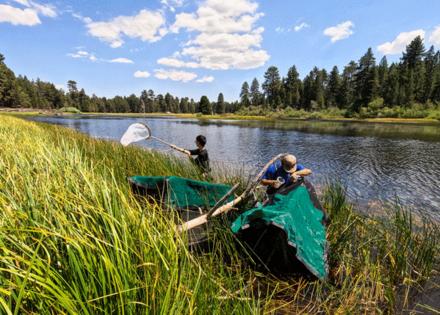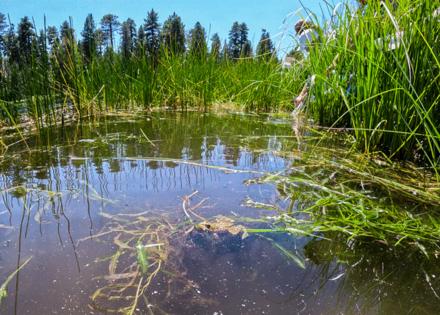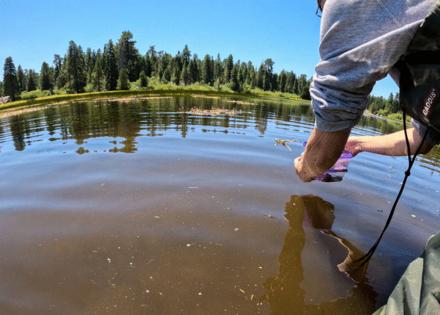Endangered frog species is hopping around Southern California once again
Published in News & Features
More than 350 frogs made the leap back into the Southern California wilderness this month, part of an effort from the Birch Aquarium and other regional partners to reintroduce an endangered species to its home waters.
The mountain yellow-legged frogs — most of which were raised at the Birch Aquarium over the last year — were released at Bluff Lake, within a preserve in the San Bernardino Mountains.
The event marked the Birch Aquarium’s first-ever species reintroduction — and was one of the largest releases of the frog species to date as researchers try to renew its population in the wild.
“It was a long time coming,” said Sean Bruce, assistant curator of fishes and invertebrates at the Birch Aquarium who helped release the frogs. “Everybody was pretty excited to hopefully see some results.”
The effort was a collaboration with the San Diego Zoo Wildlife Alliance, UCLA and Big Bear Alpine Zoo. It’s part of a larger recovery program from U.S. Fish and Wildlife Service, the U.S. Geological Survey, the California Department of Fish and Wildlife and the U.S. Forest Service.
The southern mountain yellow-legged frog has been listed as endangered since 2002. Historically found in the San Bernadino, San Gabriel and San Jacinto mountains, its population numbers decreased over the years due to drought, infection, human recreation and the introduction of nonnative species, such as trout, that eat the frog.
Up until 2023 — when 70 frogs were reintroduced at Bluff Lake — no frogs had been recorded in the area since 1951, according to Tim Krantz, conservation director for The Wildlands Conservancy, the nonprofit that manages the area.
They can be difficult to survey, too.
The mountain yellow-legged frog isn’t “a super charismatic animal,” Bruce says. They camouflage with their surroundings and don’t have a typical frog croak.
“If they go missing, it’s one of those things that people kind of notice slowly,” he said. “But at one point they were really prevalent, and now they’re not there.”
But he says amphibians can be like the canary in a coal mine — the first to go when there are climate and pollution issues that can disrupt ecosystems.
Bruce and the other teams set out for the San Bernardino Mountains in mid-August, transporting the frogs in coolers for the journey. A total of 220 frogs were raised from tadpoles at the Birch Aquarium, and the rest were raised at the San Diego Zoo and UCLA.
The frogs were released in two stages to assess which method is most effective, with one group immediately released into the lake.
The second group was released first into a specially designed habitat and monitored for about a week as the frogs acclimated to their surroundings. Bruce and the other scientists checked on the frogs daily and fed them a mix of the food they received in captivity, such as crickets, along with native insects from around the lake.
Each frog was also microchipped so scientists can keep track of them for research.
The frogs released this month may eventually be joined by more. Bruce said his team expects to receive another group of tadpoles in the coming weeks to hopefully be released next year.
©2025 The San Diego Union-Tribune. Visit sandiegouniontribune.com. Distributed by Tribune Content Agency, LLC.












Comments